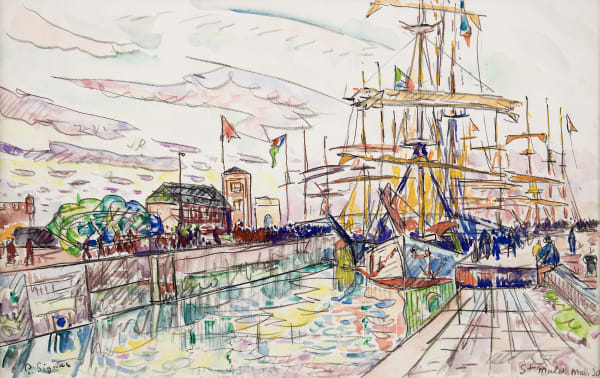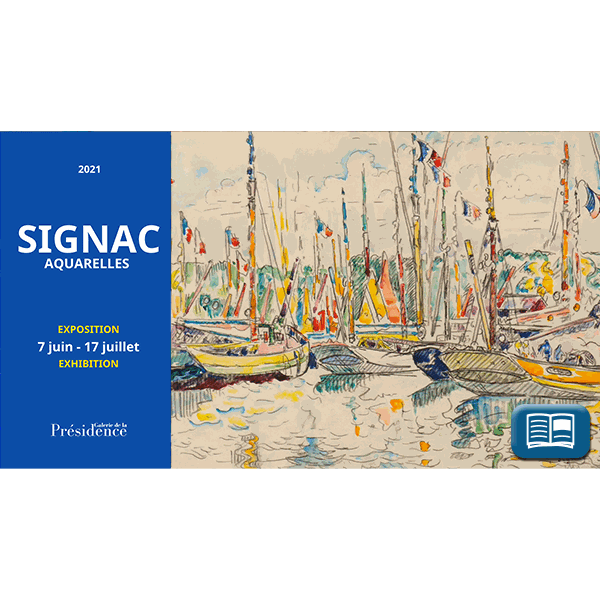Paul SIGNAC 1863-1935
-
 Paul SIGNACCollioure, 1887Oil on panel
Paul SIGNACCollioure, 1887Oil on panel -
 Paul SIGNACAntibes. 7am. Morning, 1903Oil on cardboard-canvas
Paul SIGNACAntibes. 7am. Morning, 1903Oil on cardboard-canvas -
 Paul SIGNACAntibes. 8am. Morning, 1903Oil on cardboard-canvas
Paul SIGNACAntibes. 8am. Morning, 1903Oil on cardboard-canvas -
 Paul SIGNACSaint-Tropez. Le port, 1906Watercolor on paper
Paul SIGNACSaint-Tropez. Le port, 1906Watercolor on paper -
 Paul SIGNACMarseille, 1907Watercolor on paper
Paul SIGNACMarseille, 1907Watercolor on paper -
 Paul SIGNACVenise. Bassin de Saint-Marc, 1907Brown Ink drawing on paper
Paul SIGNACVenise. Bassin de Saint-Marc, 1907Brown Ink drawing on paper -
 Paul SIGNACSaint-Tropez. The Port. The Lighthouse, 1912 circaGraphite on paper
Paul SIGNACSaint-Tropez. The Port. The Lighthouse, 1912 circaGraphite on paper -
 Paul SIGNACL'Estuaire du Trieux (The Trieux Estuary), 1925 circaWatercolor on paper
Paul SIGNACL'Estuaire du Trieux (The Trieux Estuary), 1925 circaWatercolor on paper -
 Paul SIGNACSaint-Malo. Le terre-neuvas (The Newfoundland fisher boat in Saint-Malo), 1929Watercolor on paper . From the Ports of France series.
Paul SIGNACSaint-Malo. Le terre-neuvas (The Newfoundland fisher boat in Saint-Malo), 1929Watercolor on paper . From the Ports of France series. -
 Paul SIGNACSaint-Malo, 1930Watercolor on paper
Paul SIGNACSaint-Malo, 1930Watercolor on paper
Signac, leader of neo-impressionism
Signac painted in the Impressionist manner until his meeting with Seurat, a capital turning point in his work. The following year he met Pissarro and Félix Fénéon, an art critic and the future editor of La Revue Blanche and inventor of the term Néo-Impressionism – the movement of which both Seurat and Signac were the ultimate representatives.
As early as 1886 he adopted the divisionist technique and helped it to evolve. He developed his large oil compositions in the workshop and progressively evolved towards watercolors to which he eventually dedicated himself entirely.
The sea occupies the major role is his work. A sailor at heart, he owned 32 boats over the course of his life. In 1892 he adopted the port of Saint Tropez which he painted from on board his boat.
Marked by Japanese prints until 1900, he underlined his dots with a black line. From 1902 onwards, his watercolors prefigured fauvism and the liberation of color which Matisse, under the influence of Signac and Cross, continued.
If he remained faithful to rigorous divisionism in his oils, his watercolors gave free reign to his natural vivacity. He virtuously painted the changing universe of port life and the lapping of the sea. As unique drafts, watercolors leave no room for mistakes but do allow for freer and more spontaneous fragmentation. His collection of watercolors, the diary of a tireless traveler, a complete tour of France’s ports is, in itself, a monument. He is a Master of this genre.
Last exhibitions dedicated to Paul Signac
2001
- “Paul Signac” at the Grand-Palais – Paris
- “Signac le marin” at Galerie de la Presidence
2011
- “Signac les ports de France” in the Musée Malraux in Le Havre then in the Piscine-musée d’art et d’industrie André Diligent in Roubaix.
2021
- « Signac, Aquarelles » at Galerie de la Presidence
- "Signac, les harmonies colorées" at the Musée Jacquemart-André, Paris
- "Signac collectionneur" at the Musée d'Orsay, Paris
2022
- "Signac et Saint-Tropez" at the Musée de l'Annonciade, Saint-Tropez
2025
- "Signac, du Noir à la Couleur" at Galerie de la Présidence, Paris















